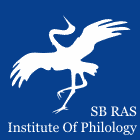 |
|
||||||||||||
|
Institute of Philology of
the Siberian Branch of Russian Academy of Sciences |
|
||||||||||||
|
|||||||||||||
| Sibirskii Filologicheskii Zhurnal (Siberian Journal of Philology) | |
|
Article
Authors: Anna A. Grinevich Institute of Philology of the Siberian Branch of the Russian Academy of Sciences, Novosibirsk, Russian Federation In the section Study of folklore
Abstract: This article addresses the long-standing issue of classifying genres in Khanty folklore, contextualizing it within the broader history of folklore theory. The discussion begins with an examination of 20th-century genre theories, from universalist models (W. Bascom and L. Honko) to context-oriented, functionalist, and performance-based perspectives (B. Malinowski, D. Ben-Amos, and R. Abrahams). Consideration is given to the limitations of universalist schemes when applied to local traditions and the necessity of integrating emic categories and na-tive terminology. Emphasis is placed on scalable classifications that categorize genres based on a set of variable characteristics instead of strict demarcations. Among the examples are Little-ton’s referentiality-based “genre square” and performance-centered models, which offer more adaptable analytical frameworks. A detailed analysis of the historiography of Ob-Ugric folklore studies is undertaken. Account is taken of the contributions of early collectors, including A. Reguly, B. Munkácsi, and S. Patkanov, as well as the later systematic endeavors of E. Schmidt and N. V. Lukina, whose content- and ritual-based classifications proved foundational. Based on the previously mentioned methods and original archival and field data, this article proposes a systematic classification of Khanty folklore genres. This classification integrates previous approaches and is characterized by multidimensionality and adaptability. The classification is based on four key principles: (1) universal terminology to facilitate cross-cultural comparison, (2) respect for local nomenclature, (3) application of multi-criteria and feature-based methodologies, and (4) scalability, which enables the modeling of overlapping and dynamic genre boundaries. The resulting typology encompasses tales, mythological narratives, songs, prayers, shamanic incantations, minor forms, and non-verbal folklore. Keywords: Khanty folklore, genre classification, Ob-Ugric peoples, universal terminology, local nomencla-ture, scalable classifications, cultural context, comparative studies, computational folkloristics Bibliography: Abello J., Broadwell P., Tangherlini T. R. Computational folkloristics. Communications of the ACM. 2012, vol. 55 (7), pp. 60–70. DOI 10.1145/2209249.2209267 Abrahams R. D. Patterns of structure and role relationships in the child ballad in the United States. The Journal of American Folklore. 1966, vol. 79 (313), pp. 448–462. Baer K. Kurzer Bericht über wissenschaftliche Arbeiten und Reisen, welche zur nähern Kenntniss des Russischen Reichs in Bezug auf seine Topographie, physische Beschaffenheit, seine Naturproducte, den Zustand seiner Bewohner u. s. w. in der letzten Zeit ausgeführt, fortgesetzt oder eingeleitet sind. Beiträge zur Kenntniss des Russischen Reiches und der angränzenden Länder Asiens. 1845, vol. 9, 350 p. URL: https://www.etera.ee/zoom/9768/view?page=6&p=separate&tool=info&view=0,0,2575,4323 (accessed 20.10.2025). Bakhtin M. M. Estetika slovesnogo tvorchestva [The aesthetics of verbal creativity]. Moscow, Leningrad, Iskusstvo, 1986, 445 p. Balandin A. N. Yazyk mansiyskoy skazki [The language of the Mansi fairy tale]. Leningrad, Izd. Glavsevmorputi, 1939, 80 p. Bascom W. The forms of folklore: Prose narratives. The Journal of American Folklore. 1965, vol. 78, pp. 3–20. Ben-Amos D. Do we need ideal type (in Folklore)? An address to Lauri Honko. Nordic Institute of Folklore. 1992, pp. 3–37. Geertz C. The Interpretation of Cultures. 1973, 470 p. Jansen W. H. Classifying performance in the study of verbal folklore. Studies in Folklore: In Honor of Distinguished Service Professor Stith Thompson. 1957, vol. 9, pp. 110–118. Honko L. Genre Analysis in Folkloristics and Comparative Religion. Temenos – Nordic Journal of Comparative. 1968, vol. 3, pp. 48–66. Kolpakova N. P. Russkaya narodnaya bytovaya pesnya [Russian folk everyday song]. Moscow, AN SSSR, 1962, 284 p. Littleton C. S. A two-dimensional scheme for the classification of narratives. The Journal of American Folklore. 1965, vol. 78, pp. 21–27. Lukina N. V. Mify, predaniya, skazki khantov i mansi [Myths, legends, and tales of the Khanty and Mansi]. Moscow, Nauka, 1990, 568 p. Lukina N. V., Ryndina O. M. Istochniki po etnografii Zapadnoy Sibiri [Sources on the ethnography of Western Siberia]. Tomsk, TSU, 1987, 284 р. Lukina N. V., Shmidt E. O klassifikatsii prozaicheskikh zhanrov v fol’klore obskikh ugrov [On the classification of prose traditions in Ugric folklore]. In: XVII Vsesoyuz. finno-ugorskaya konf. Arkheologiya, antropologiya i genetika, etnografiya, fol'kloristika, literaturovedenie: Tez. dokl. [XVII All-Ugric Finno-Ugric Conference. Archaeology, Anthropology and Genetics, Ethnography, Folklore, Literature Studies: Theses]. Ustinov, 1987, pp. 266–268. Malinowski B. Myth in Primitive Psychology. 1926, 130 p. Meaney J. A., Alex B., Lamb W. Evaluating and adapting large language models to represent folktales in lowresource languages. 2024. URL: https://arxiv.org/pdf/2411. 05593 (accessed 05.06.2025). Munkacsi B. Regek es énekek a világ teremteserol. A vogul-osztják népköltés irodalma s főbb sajátságai. A yogül nép ősi hitvilága. Tárgyi és nyelvi magyarázatok. Budapest, 1902, vol. 1, 294 p. Patkanov S. Die Irtisch-Ostjaken und ihre Volkspoesie: Vol. II. Teil. Ostjakischt texte mit Deutscher und Russischer Übersetzung nebst erlӓuterungen. St. Petersburg, l’Académie Impériale des Sciences, 1900, 302 p., 1897. Propp V. Ya. Printsipy klassifikatsii fol’klornykh zhanrov [Principles of classification of folklore genres]. Sovetskaya Etnografiya. 1964, no. 4, pp. 147–154. Putilov B. N. Russkaya istoricheskaya pesnya [Russian historical song]. In: Narodnyy istoricheskie pesni [Folk historical songs]. B. N. Putilov (Introd., text prep. and notes). Moscow, Leningrad, 1962, pр. 5–53. Putilov B. N. Fol’klor i narodnaya kul’tura [Folklore and traditional culture]. St. Petersburg, Peterb. Vostokovedenie. 1994, 457 p. URL: https://www.booksite.ru/fulltext/ 1/001/001/084/ (accessed 06.09.2025). Rosillo-Rodes P., Maxi S. M., Sanchez D. Computational lexical analysis of Fla-menco genres. 2024. URL: https://arxiv.org/pdf/2405.05723 (accessed 01.09.2025). Toporov V. N. Folk Poetry: General Problems. In: Current trends in linguistics. Sebeok T. (Ed.). The Hague Paris, Mouton, 1974, vol. 12: Linguistics and adjacent arts and sciences, pt. 2, pp. 683–740. Toporov V. N. K probleme zhanrov v fol’klore [On the Problem of Genres in Folklore]. In: Materialy Vsesoyuznogo simpoziuma po vtorichnym modeliruyushchim sistemam [Proceedings of the All-Union Symposium on Secondary Modeling Systems]. Tartu, 1974, vol. 1 (5), pp. 3–16. |
 |
Institute of Philology Nikolaeva st., 8, Novosibirsk, 630090, Russian Federation +7-383-330-15-18, ifl@philology.nsc.ru |
© Institute of Philology |


